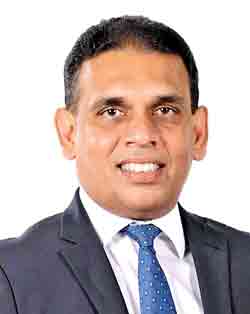Tuesday Nov 11, 2025
Tuesday Nov 11, 2025
Tuesday, 11 November 2025 03:20 - - {{hitsCtrl.values.hits}}
By Charumini de Silva
 |
| SLAITO President Nalin Jayasundera |
Sri Lanka Association of Inbound Tour Operators (SLAITO) President Nalin Jayasundera yesterday welcomed the Budget 2026 proposals to upgrade domestic and international airport infrastructure and improve road connectivity, but cautioned that without a robust, consistent marketing strategy, the country will struggle to attract year-round visitors.
“Overall, the Budget 2026 is good,” he told the Daily FT.
Jayasundera said the tourism industry appreciates the Government’s plans to develop the domestic airports in Hingurakgoda, Sigiriya, and Trincomalee, expand operations at the Jaffna International Airport, and resume expansion of the Bandaranaike International Airport (BIA).
He also welcomed the continued investment in expressway and key road projects, including the Central Expressway, Kurunegala-Dambulla Expressway, and Ruwanpura Expressway, noting that improved road connectivity will significantly enhance accessibility to key tourist destinations.
“Accessibility is key and this requires infrastructure and transport solutions. Without those, we will struggle to attract year-round visitors. We are glad the Government has taken some of the proposals the industry has suggested,” Jayasundera cautioned.
He also welcomed the reduction in the Value-Added Tax (VAT) threshold from Rs. 60 million to Rs. 36 million per annum, effective from 1 April 2026, noting that the move could discourage companies to split operations to remain below the threshold and avoid taxes.
Jayasundera further stressed that while Sri Lanka is making progress in infrastructure and investment, the missing piece remains a strong and sustained destination marketing effort.
“Sri Lanka needs the necessary infrastructure, hotels, and attractions in place, but without a consistent global marketing strategy, we cannot fully unlock our tourism potential,” he said.
The 2026 Budget projects an ambitious expansion of Sri Lanka’s tourism sector, targeting $ 8 billion in annual earnings and 4 million visitors by 2030. The Government said the strategy combines institutional reforms, infrastructure development, human resource training, and a cohesive global marketing campaign to strengthen the industry’s competitiveness.
According to the Budget speech delivered by President Anura Kumara Dissanayake, the tourism sector will undergo a restructuring of its key institutions to resolve longstanding coordination issues among stakeholders. The Government aims to boost productivity and efficiency, while ensuring that destination development, environmental restoration, and promotional activities move in tandem.
A Rs. 3.5 billion destination development initiative will focus on nature and heritage-based tourism, including coastal and marine restoration in the Western Province, such as the Hamilton Canal and Negombo Lagoon. The Haputale area, along with Beragala and Idalgashinna, will also be developed as major tourism zones through infrastructure upgrades and targeted publicity campaigns.
More than 900 State-owned tourist bungalows and resorts, many located in high-demand areas, are to be redeveloped with private sector collaboration to increase accommodation capacity. To meet the estimated demand for over 800,000 skilled workers by 2030, the Sri Lanka Institute of Tourism and Hotel Management (SLITHM) will expand training through a new Hospitality Multi-Purpose Program supported by Rs. 500 million from the Tourism Development Fund.
A further Rs. 2.5 billion from the same fund will be used to redevelop Beira Lake as a central urban attraction. On connectivity, Rs. 1 billion will be allocated to develop domestic airports in Sigiriya, Trincomalee, and Hingurakgoda, with plans to expand operations at the Jaffna International Airport.
The Government also reaffirmed its intention to resume the long-delayed Bandaranaike International Airport (BIA) expansion early next year, and pursue debt restructuring for SriLankan Airlines, positioning the country as a regional transit hub.
ADB approves $ 100 m to strengthen Sri Lanka’s fiscal resilience and transparency
The Asian Development Bank (ADB) yesterday said it has approved a $ 100 million financing package to build on Sri Lanka’s progress toward macroeconomic stability and to help achieve sustainable growth following the economic crisis.
This will be done by strengthening public expenditure management, improving revenue mobilisation, and fostering private sector participations.
ADB Sri Lanka Country Director Takafumi Kadono said: “Sri Lanka has made commendable progress in restoring fiscal and debt sustainability following an unprecedented economic crisis. We will work closely with the Government to restore macroeconomic stability and promote inclusive, sustainable growth by strengthening Sri Lanka’s fiscal governance and build a more efficient, accountable, and resilient public sector”.
“This program also aims to improve the credibility and execution of public expenditure, enhance domestic revenue mobilisation, and foster a more predictable and transparent investment climate,” Kadono added.
This program will help improve efficiency and transparency in public expenditure management through a comprehensive approach that streamlines budgetary processes and optimises resource allocation to ensure the effective utilisation of public funds.
In addition, it will enhance revenue mobilisation by strengthening revenue generation through stronger domestic and international tax compliance such as the development and implementation of a multiyear tax compliance improvement strategy and by further deepening international tax cooperation following Sri Lanka’s recent membership to the Global Forum on Transparency and Exchange of Information for Tax Purposes.
The program will support the Government’s efforts to improve the enabling environment for private sector participation, including developing a legal framework for public–private partnerships (PPP) that is aligned with international best practices and mobilising additional climate finance and private investment. It will also focus on strengthening the management, transparency, and accountability of State-owned enterprises (SOE).
Several first-time initiatives in Sri Lanka will be supported, the ADB said.
In addition to the draft PPP law, this includes a comprehensive Fiscal Risk Statement and a climate finance strategy that aims to crowd in other sources of finance to support Sri Lanka’s climate ambition and resilience.
It also addresses gender gaps through Sustainable Development Goals budget tagging, a new gender sensitive Nationally Determined Contribution, and public procurement reforms to enhance its development impact and inclusivity. These innovations, together with newly established institutional mechanisms, such as the SOE credit risk framework and specialised monitoring units, lay the foundation for sustained impact, the ADB said.